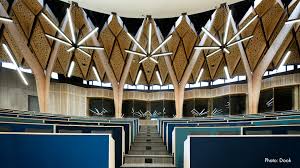 A Puzzle in Plywood: Future Africa Innovation Campus in Pretoria
A Puzzle in Plywood: Future Africa Innovation Campus in Pretoria
André Eksteen's brief for the Future Africa Innovation Campus in Pretoria was a challenge: “The architecture of the campus should play an active role in shaping minds as much as it does in shaping environments.”
André, the award-winning architect and founding partner in Earthworld Architects, a multi-disciplinary architecture practice in South Africa, was asked to design and build 280 one-, two- and three-bed residential units, a dining hall, a research building and a conference centre.
WISA-Birch plywood was used in a building frame, wall panelling, furniture, doors and ceilings. Easy to customise, it is used in all kinds of formwork throughout the world. But seldom to this extent in a construction project.
Engineered wood specialists Universal Plywood, a South African company, are the biggest distributor of WISA plywood from UPM in sub-Saharan Africa.
Universal Plywood MD Brad Anderson swiftly realised that constructing the campus residential units, conference centre, dining hall and research building would be totally different. “This was a pioneering project because in South Africa we mostly build with bricks and mortar and steel, we don't have major timber roof sections or frames.”
Staff and students have just begun using the site, dedicated to inter-disciplinary post-doctoral research.
A perfect fit
Buildings were designed like puzzles, to be prefabricated, brought to the site and constructed using low-skilled labour. The idea was to establish a template for other projects in future.
“We said let's employ a design approach that would stimulate the involvement of small businesses and SMEs and use technology that won't require highly qualified people. That's when we used digital manufacturing to cut and bend and drill very accurately. Then we utilised unskilled labour to assemble everything – that's where the magic comes in,” André explains.
“There were small pieces one man could handle and two or three could assemble. They were all glued and bolted together. What I really liked about the plywood is that there's so little waste – though next time I would manage that even better.
Brad points out that the use of CNC machinery ensured everything fitted together. “The tolerances were NIL – 0 mm! You don't get that accuracy building with steel. André and BIM Manager Arné Gunter developed a 'puzzle' which had to fit together. The feat of assembling such a complex structure on site was made possible by computerised cutting, laminating and bolting. By mobilising digital technology and parametric design, the cutting of the puzzle pieces could be outsourced to small factories and hand-assembled, on site where possible.
“The portal frame in the dining hall and massive beams in the conference centre both support a really heavy roof. Everything is pre-cut and assembled on site incredibly quickly, which surprised even the builders. And we didn't need huge teams of people or specialists, we had a few general workers with a team leader assembling,” Brad points out.
The start of something big
Brad, whose company has worked closely with UPM for well over seven years, knows plywood inside out: “It has so many applications for concrete forms, structural boards, mezzanine and truck floors, and furniture.”
“We could have 'plyscrapers', multi storey buildings made out of wood. The first step will be pre-assembled buildings,” Brad describes his own vision for the future for plywood and building in South Africa. “As a company we want to look for solutions, to bring more wood into building projects in a country built on bricks and steel. But there's so much that can be done, and it's a healthy way to build with the right kind of footprint, replacing steel with wood.
“To sit inside a building like this is quite overpowering. It really brings back to you where we started – building with timber. Everything around you is 100% sustainable, built with organic material and not cutting down a rainforest. This is definitely the way to go.”
André is now extremely keen to do more with this way of working. “This is the start of something big, I think for the whole African continent,” Andre affirms. “The way the material works, it's so versatile. I am keen to do more. If you could design a kit and local people could establish little factories to cut it, they could build for themselves?”
Text: Jane Garner
